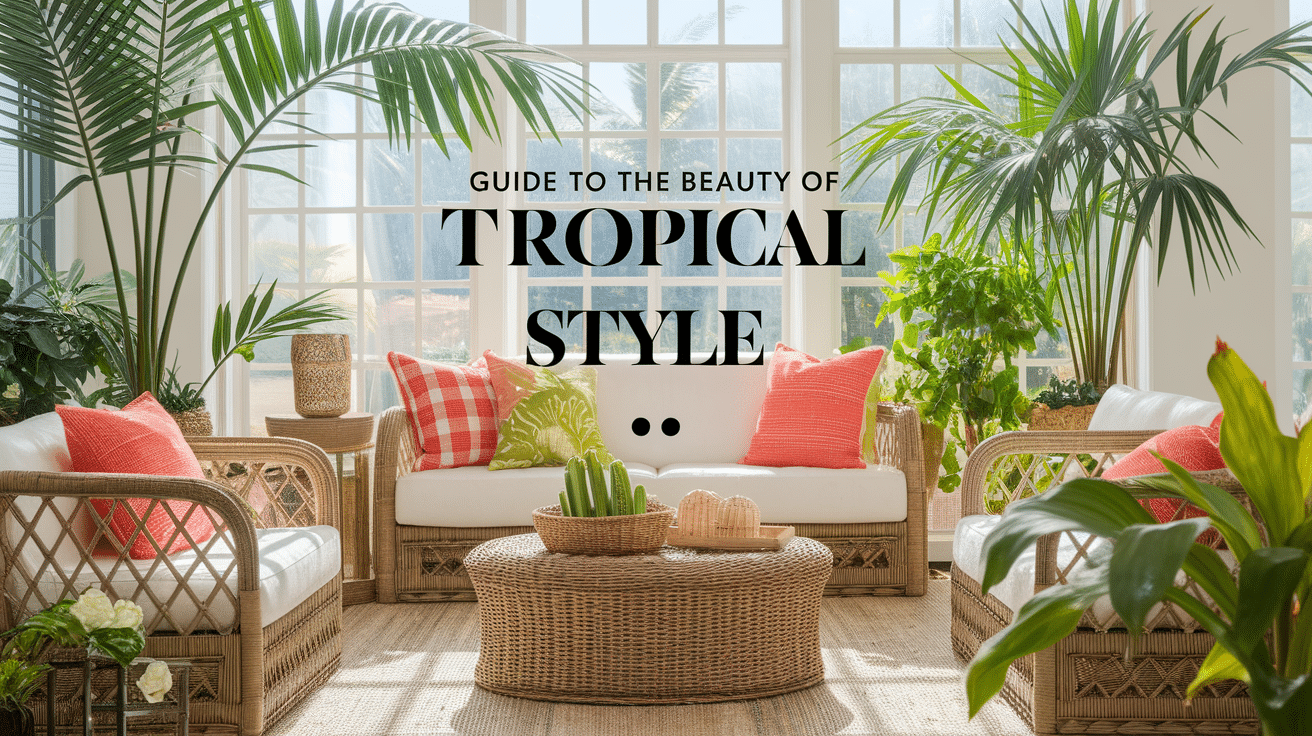If you’re looking to refresh your home with a tropical vibe, you’re in the right place. In this article, I’ll show you how to bring vibrant colors, natural materials, and a relaxed atmosphere into your living space. I’ll walk you through the key elements of tropical design and give you simple tips to create a tropical oasis at home.
If you’re looking to start, starting with small changes or bigger changes, this guide will help you make it happen.
I know it can be overwhelming to figure out where to start. That’s why I’m here to help. By the end, you’ll have a clear understanding of tropical style and how to make it work for you. Let’s get started!
Understanding Tropical Style Interior Design
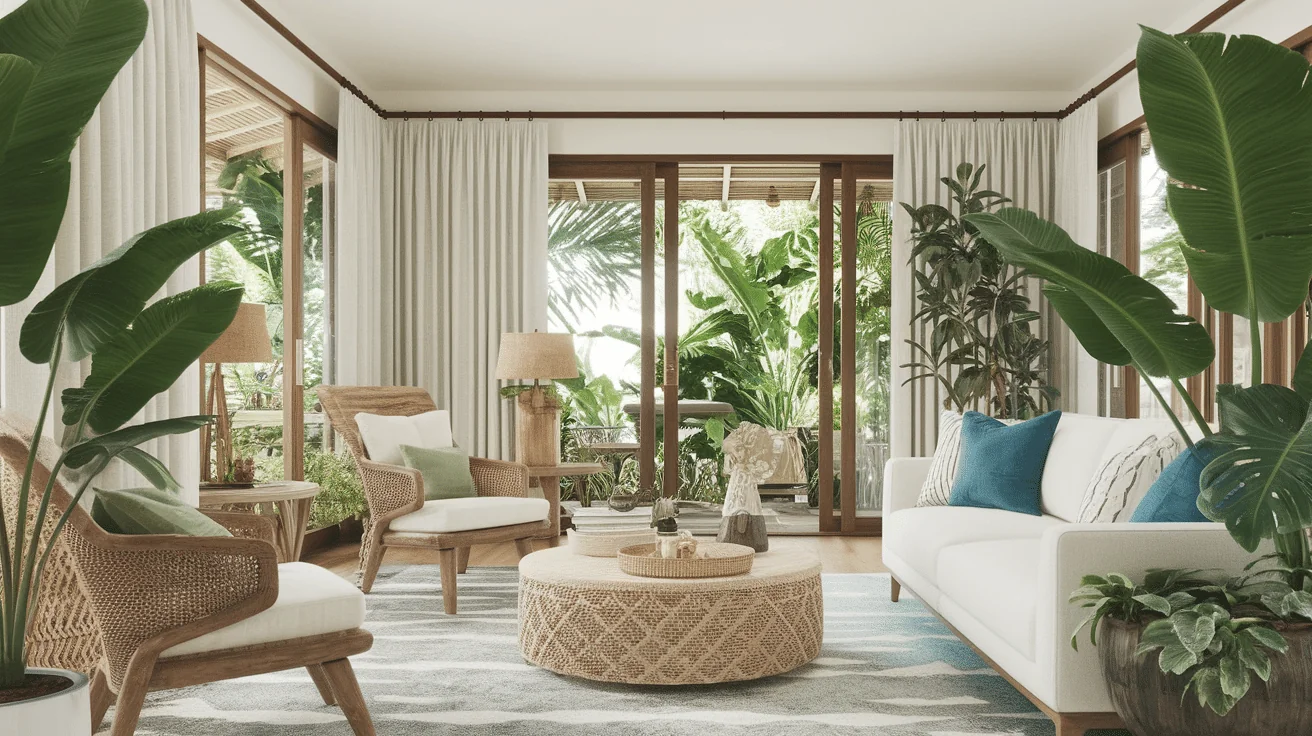
Tropical style is all about creating a space that feels calm and connected to nature. It’s inspired by warm, lush environments where you can relax and breathe easy.
At its core, the tropical style is about bringing the outdoors in. Think green plants, wooden furniture, and natural textures. The goal is to create a space that feels like a peaceful retreat.
The colors are bright and welcoming. Shades of green, blue, and earthy tones are often used, helping to make the space feel fresh and open.
What’s great about the tropical style is its simplicity. It doesn’t need to be complicated. It’s just about creating a soothing environment where you can unwind.
Key Characteristics of Tropical Design
Tropical design is known for its vibrant colors and natural materials. Let’s examine the key elements that make it so special.
Color Palette
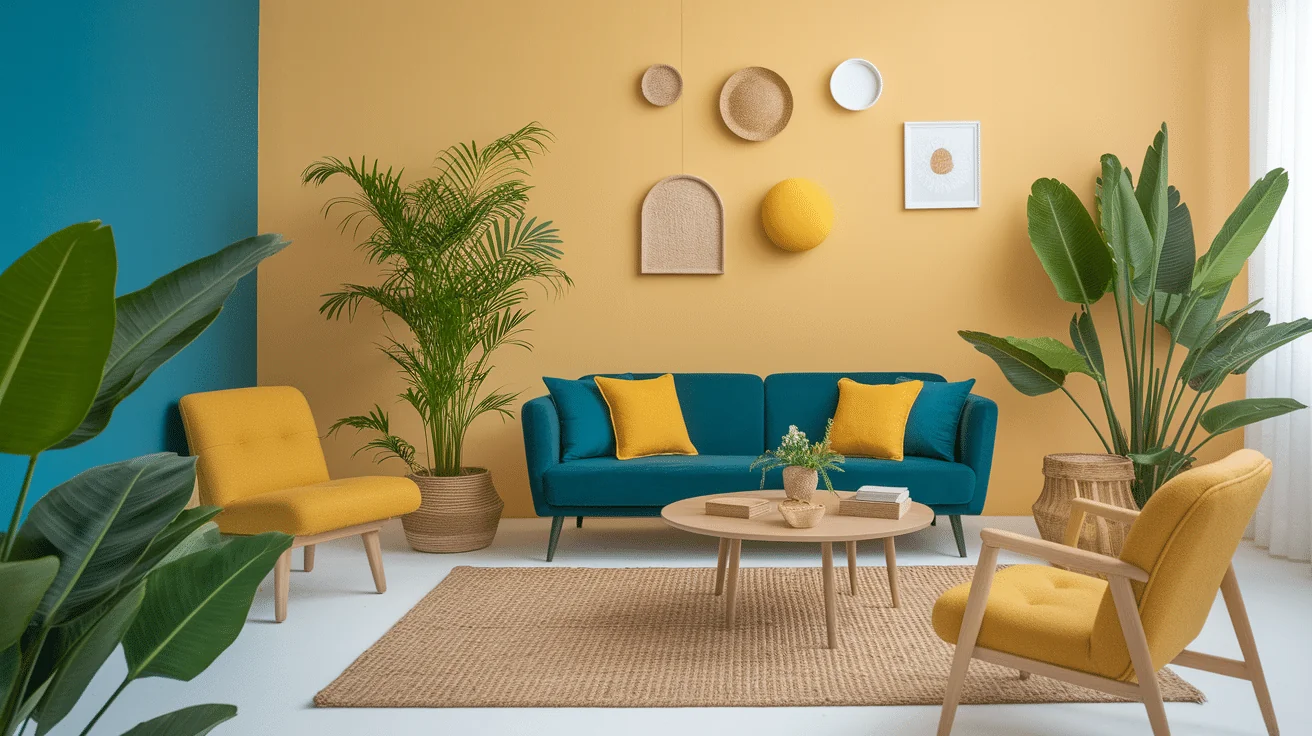
The colors in tropical design are bold and lively. You’ll see lush greens, like the leaves of tropical plants. Ocean blues remind you of the sea. Warm yellows bring in the sun. These bright shades are balanced by neutral tones—like beige or soft browns—to make the space feel inviting, not overwhelming.
A tropical space feels refreshing but never harsh, with colors that bring peace and energy.
Natural Materials
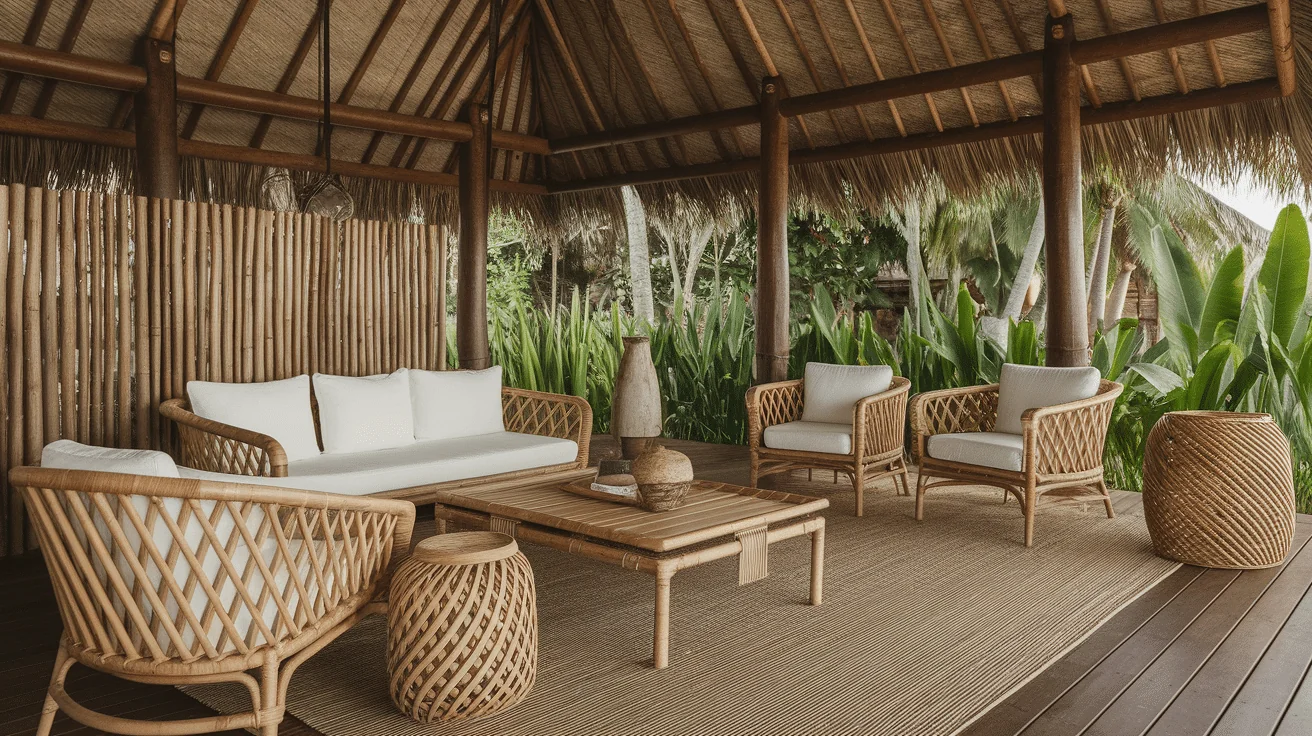
Tropical style loves using natural materials. Furniture made from bamboo, rattan, wicker, and wood add texture and give the space a more authentic feel.
It’s about keeping things simple and grounded in nature. These materials also help the space feel cooler, which is great for warmer climates. By incorporating these, you get a warm, cozy feeling that still connects you to nature.
Indoor-Outdoor Connection
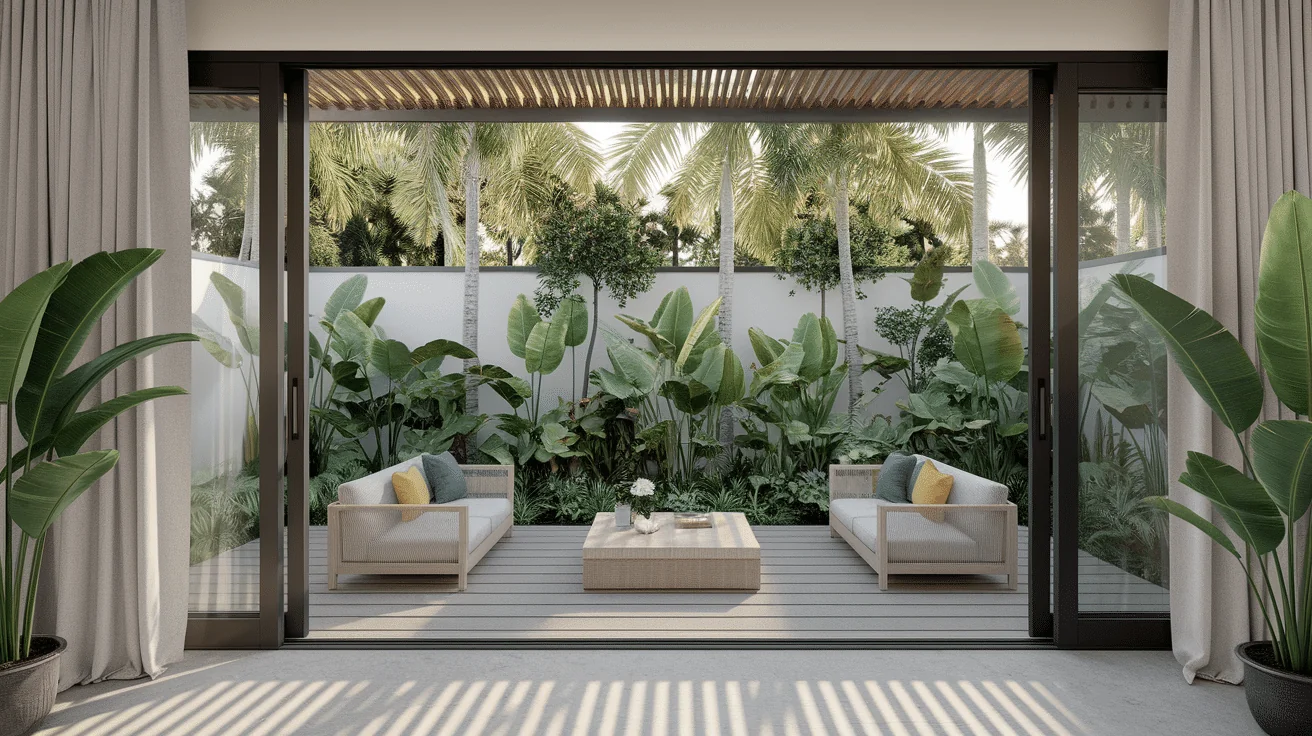
In tropical design, the outdoors and indoors blend. Large windows bring in natural light, and open layouts make the space feel bigger. And, of course, tropical plants help blur the lines even more.
This connection with nature helps create a relaxing environment. It’s important to make your home feel like a retreat, where the outside world is always just within reach. Plants, sliding doors, and terraces help you feel more at one with your surroundings.
By combining these elements, tropical design transforms a space into a peaceful sanctuary. The key is balance—vibrant colors, natural textures, and an open, airy feel. It’s about creating a home that lets you unwind and reconnect with nature every day.
Essential Elements to Incorporate
When it comes to tropical design, the right furniture, textiles, and decor can make all the difference. Here’s how you can bring tropical style into your home.
Furniture
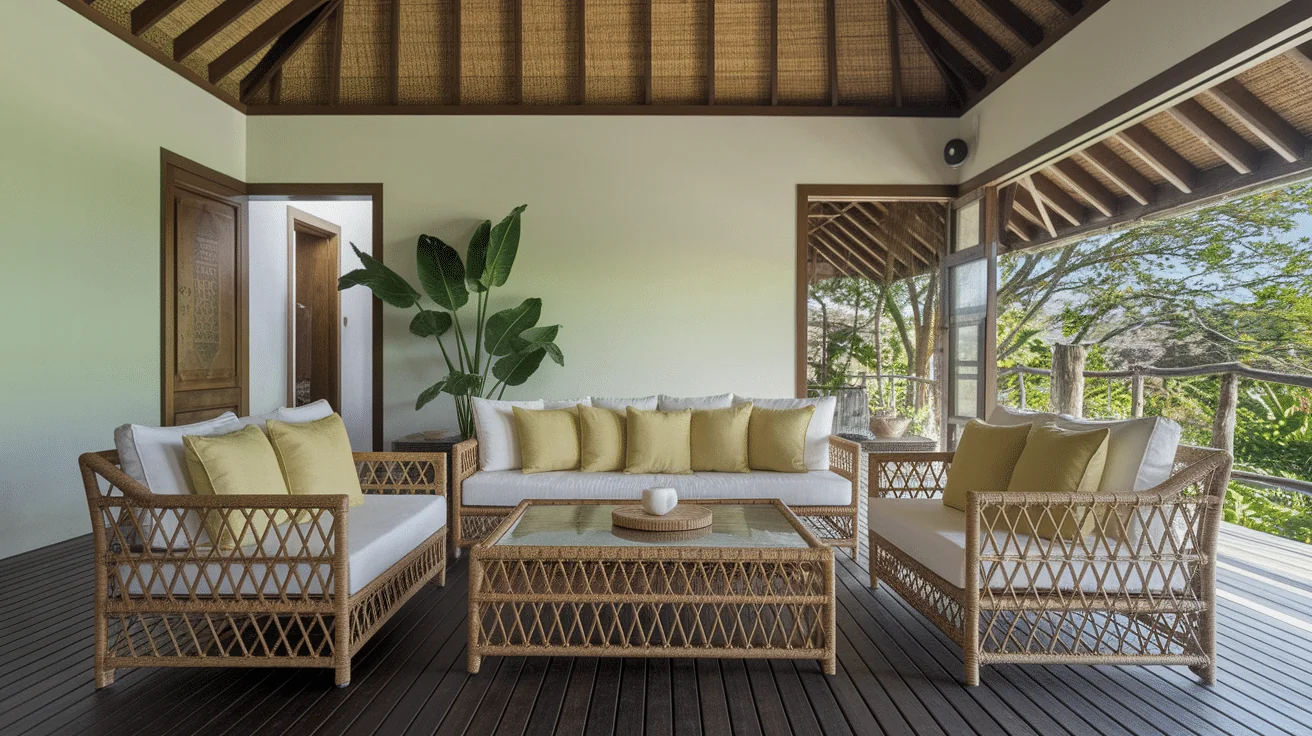
Start with natural materials. Furniture made from rattan, bamboo, or wood works perfectly in a tropical space. These materials bring in an earthy, relaxed feel.
Choose pieces that are comfortable and functional. For example, a wicker chair or a bamboo table will look great and provide a cozy spot to relax. Remember, tropical design isn’t just about looks—comfort is key.
Textiles
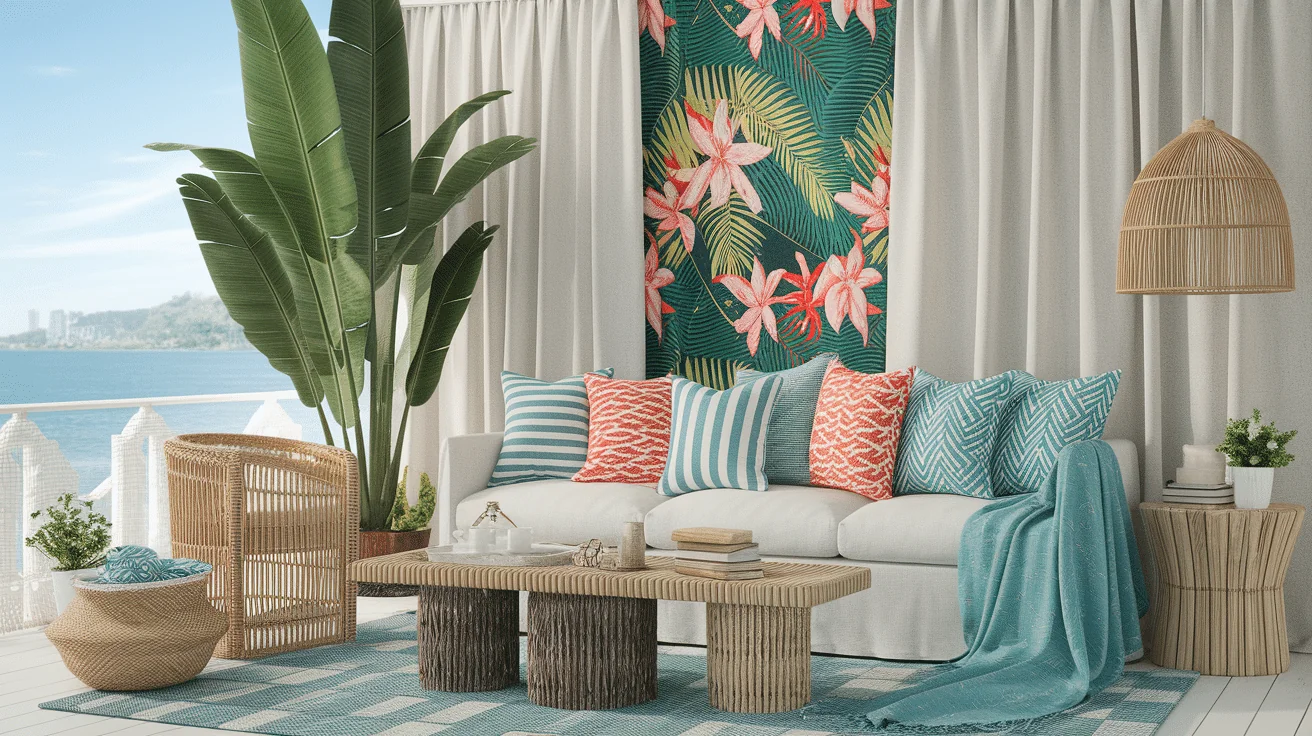
Choose breathable and lightweight fabrics for textiles. Linen and cotton are great choices, especially for tropical climates. They’re cool to the touch and easy to maintain.
Look for fabrics with tropical patterns—think palms, flowers, and waves. These fabrics can add fun details without overwhelming the space.
Decor
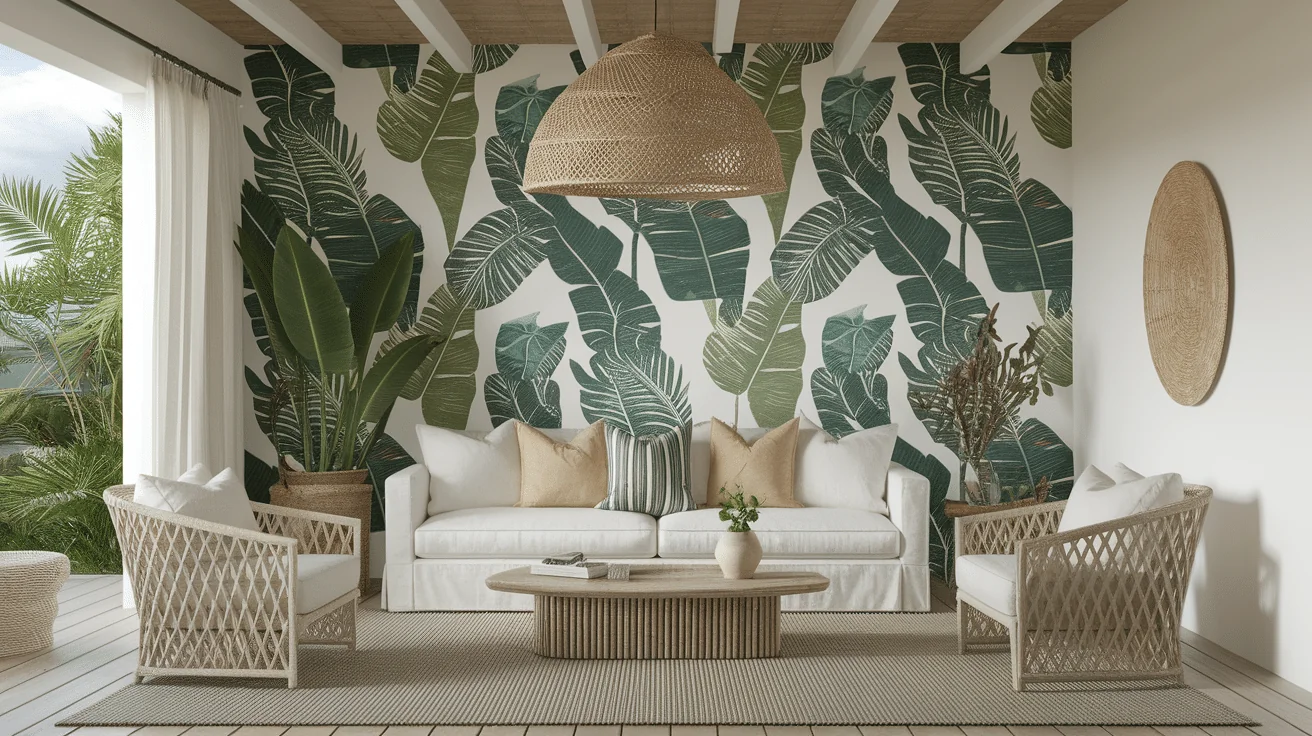
Tropical decor is all about nature-inspired items. Try adding tropical leaf prints to your walls or throw pillows. Seashell accents or handcrafted accessories like woven baskets or wooden sculptures can add charm. These little touches help bring the outside in, giving your space that relaxing tropical vibe.
By choosing the right furniture, textiles, and decor, you can create a tropical environment that is both beautiful and functional. It’s about embracing nature while staying comfortable and relaxed.
Creating a Tropical Oasis in Different Rooms
Tropical style isn’t just for one room. You can create that relaxed vibe all over your home. Here’s how to bring the tropical feel into your living room, bedroom, and outdoor spaces.
Living Room
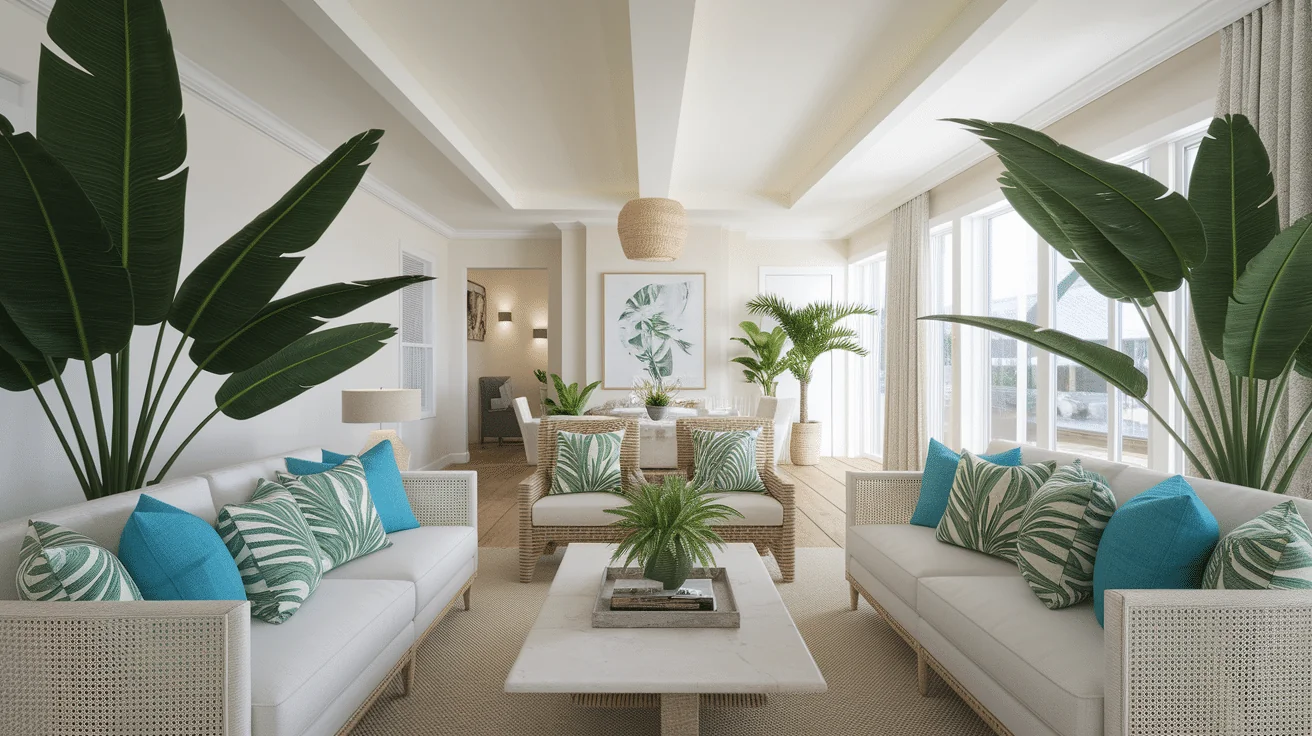
Start with seating. Arrange your chairs and couches to encourage conversation or relaxation. Light-colored furnishings help make the room feel airy and open—you don’t want the space to feel heavy.
Add plants—big, green ones! They bring life to the room and give it a lush, tropical feel. For an extra touch of charm, place a few throw pillows with tropical patterns.
Bedroom
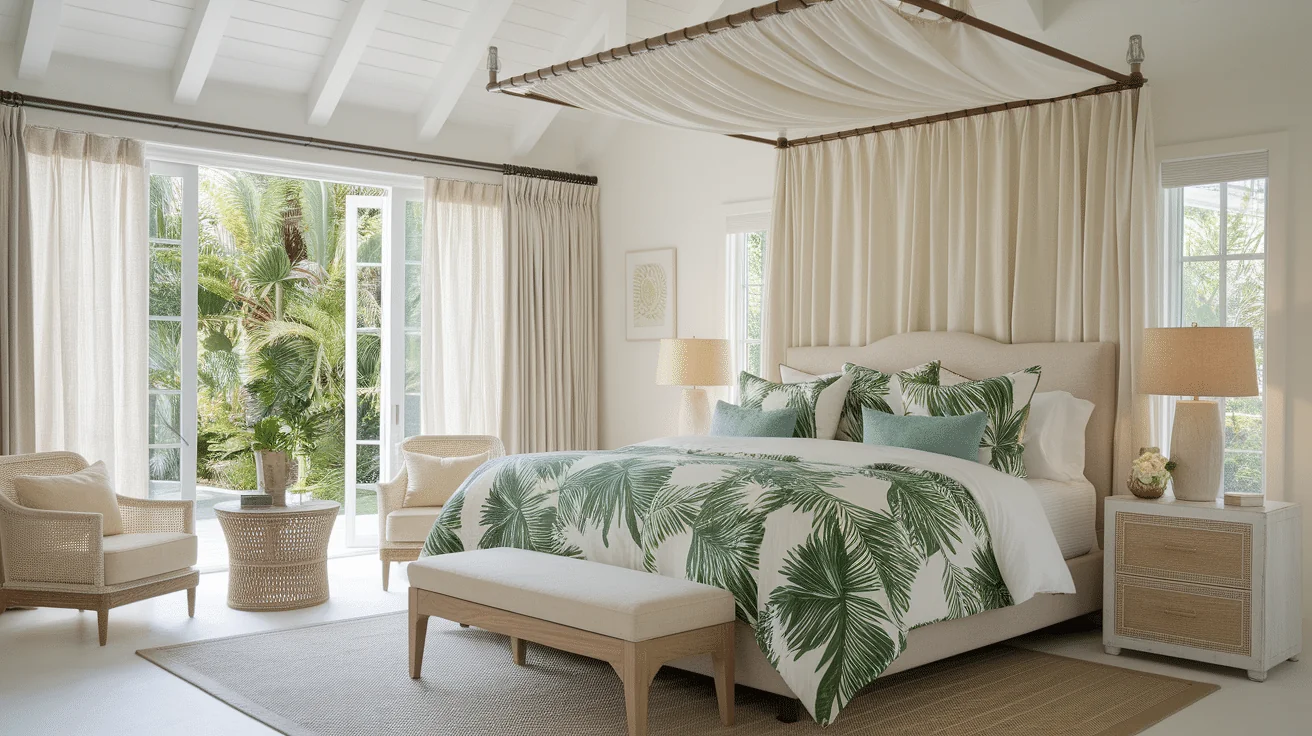
The bedroom should feel like a peaceful retreat. A canopied bed can give the room a cozy, tropical look. Choose tropical-themed bedding with palm leaves or floral prints.
It adds color and life. Make sure there’s plenty of natural light. Big windows or light curtains can help fill the room with sunlight. A bright, airy bedroom is key for a restful environment.
Outdoor Spaces
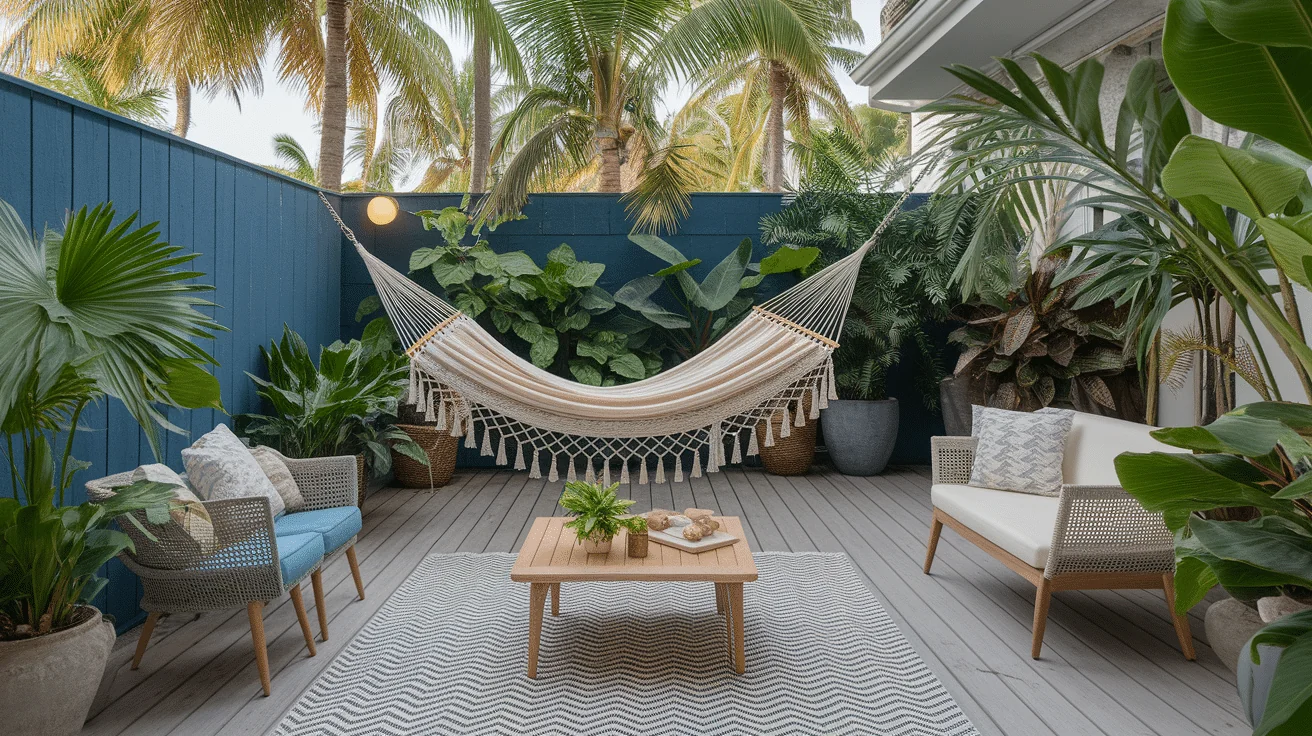
Take the tropical vibe outside! Add a hammock for the perfect spot to relax, and lay down an outdoor rug to tie the space together.
Surround the area with tropical plants like palms or ferns. This will help extend the tropical feel beyond your walls and create a peaceful outdoor retreat.
By focusing on these simple changes, you can turn any room or outdoor space into a tropical oasis.
Common Mistakes to Avoid
When creating a tropical space, it’s easy to get excited and make a few mistakes. Here are some things to watch out for.
Overcrowding with Decor
It can be tempting to add lots of tropical decor—leaf prints, seashells, and tropical flowers—but be careful. Too many items can make your space feel cluttered instead of calming. Remember, less is often more. Choose a few key pieces that stand out, and let the space breathe.
Neglecting Functionality
It’s easy to focus on how things look, but don’t forget about functionality. A beautiful room should also be practical. Make sure your furniture is comfortable and serves a purpose.
Is the space easy to move around in? Does the room have enough storage? Make sure it’s both beautiful and livable.
Ignoring Climate Considerations
Tropical design is perfect for warm climates. But keep the local environment in mind. Choose materials that will hold up well, like wood or bamboo.
Make sure your furniture and decor are suitable for your area. You want your tropical oasis to be durable and comfortable, no matter the weather.
Avoiding these mistakes will help you create a tropical space that’s relaxing, functional, and long-lasting.
Conclusion
Tropical style is all about creating a vibrant, relaxed space that connects you to nature. By using bright colors, natural materials and incorporating indoor plants, you can bring the outdoors inside. Remember to choose comfortable, functional furniture and balance aesthetics with practicality. Whether it’s your living room, bedroom, or outdoor space, tropical design can transform your home into a peaceful retreat.
I’d love to hear how you’ve embraced tropical style in your own space! Feel free to share your thoughts or experiences in the comments below. Let’s keep the conversation going and inspire each other to create beautiful, relaxing environments.
Frequently Asked Questions
What are the best plants for a tropical-style home?
Plants like palms, ferns, philodendrons, and bamboo work well in tropical spaces. They add lush greenery and enhance the tropical vibe in your home.
Can tropical style work in smaller rooms?
Yes, the tropical style can work in small spaces. Use light-colored furniture, mirrors, and plants to create the illusion of space while maintaining that airy, natural feel.
How can I add a tropical style on a budget?
Focus on affordable touches like tropical-patterned throw pillows, DIY plants, and natural woven baskets. Small, simple changes can have a big impact.

